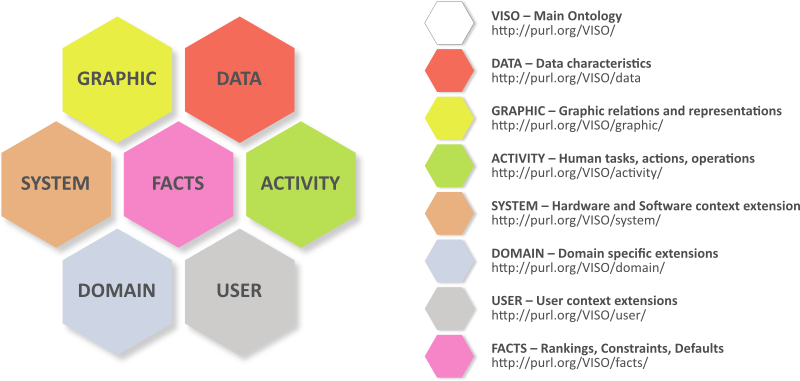
The Visualisation Ontology (VISO) defines concepts and relations from the field of graphics and visualisation. The ontology is split into seven main modules, each being concerned with a specific field of visualisation. These modules include the graphic module, the data module and the facts module and other modules such as activities and system context modules*.
More on VISO can be found in the Wiki and our Blog.
*) The context module VISO/user and the module VISO/domain are partly implemented and not published for now.
VISO has been developed as a base for the RDFS/OWL Visualisation Language (RVL) and VizBoard - a generic InfoVis workbench for semantic data. However, VISO could also be employed for other purposes in future:
Pointing your web browser to VISO (modules) should show you a documentation like this. Tools such as Protégé and TopBraid Composer will instead download the actual ontology files from the same URI, so it should usually be sufficient to point these tools to the VISO main module (http://purl.org/viso/) or one of the other modules listed above. Unfortunately, right-clicking the links and choosing "save as ..." does not seem to work in all browsers, but you should be able to display the ontology's source code by clicking on "Ontology source code" in the page header. If you want to use VISO, download it from our GitHub repository and contact us directly (jan.polowinski at tu-dresden.de) if you experience any trouble.
Allmost every term in VISO is explicitly related to the existing visualisation literature via a reference to a document, sometimes also quoting the exact phrase where it is mentioned. In order to make these annotations and the bibliography searchable via SPARQL, they are stored in RDF as well, based on the BIBO vocabulary and a small extension vocabulary, BIBO-Extension that we created for annotating ontology concepts with BIBO quotations. In summary these ontologies are:
Work on this project received financial support from the European Union and the
Free State of Saxony.
This HTML document was obtained by processing the OWL ontology source code through LODE, Live OWL Documentation Environment, developed by Silvio Peroni.